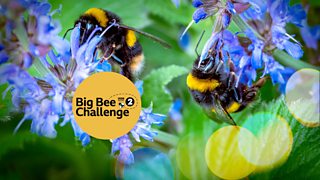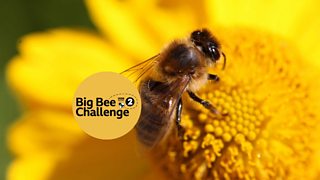Big Bee Challenge - Get involved!
Help keep the bees buzzing, by getting involved with Radio 2’s Big Bee Challenge.
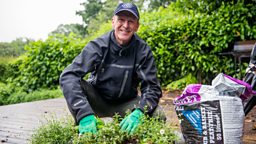
This summer we’ve been challenging the nation to help save the bees!
Our world would look very different without our buzzing buddies. They’re vital for a lot of the food we eat: imagine no apples, tomatoes, coffee or chocolate. Our gardens would be a lot less colourful too, because bees pollinate our flowers.
But, our bees are in trouble. Thirteen species in the UK have become extinct, with many more in danger. The good news is that there are things we can ALL do to help.
We're calling on EVERYONE to get out there and do ONE thing in our gardens, backyards, pots and balconies to help our precious pollinators.
Just pick ONE of these to get started…
🐝 Feed The Bees!
The most important thing we can do to help save our bees is to get planting. Bees need pollen and nectar to thrive, and as we’ve built more roads and houses and changed how we farm, there’s less food for these precious insects. Let’s help turn our 22 million gardens here in the UK into a bee buffet!
"Why not plant a herb garden in a pot or tub – marjoram, thyme, sage and mint are all much loved by bees."Professor Dave Goulson
Bees love flowers in blues, purples and yellow, with single petals that provide easy access for the bees. It’s not just flowers; trees, fruit and vegetables are also a great source of food and habitat. We’ve got more tips here.
Even in mid-summer there are still plants you can grow in a bed, pot or window box which will help support the bees, even those still buzzing into Autumn and Winter.
Our very own Dr Bee, Dave Goulson, Professor of Biology at the University of Sussex says:
"It isn’t too late to buy late-summering bee-friendly plants such as Echinacea, Rudbeckia or Helenium, in time to give pollinators a welcome nectar boost before autumn arrives. Or why not plant a herb garden in a pot or tub – marjoram, thyme, sage and mint are all much loved by bees and add flavour to your food too."

🐝 Make A Bee Hotel
Help the bees find somewhere to nest and rest. Different bees like different habitats, bumblebees will use dry, dark cavities to nest such as abandoned rodent holes, compost heaps or under sheds, so not being too tidy is a perfect way to help the bees!
Solitary bees are the biggest group of bee species in the UK, and they are most likely to use a bee hotel. Try and make this very simple DIY one below and pop it off the ground in a south-facing spot. Or drill holes of around 8mm in an old log, a block of wood, a fence post or the corner of a shed (don’t drill all the way through!) to attract bees like Mason bees.
If you notice that the ends of the tubes are plugged with mud, leaves, resin or fine plant hairs, then you know your hotel has guests!
If you’re considering keeping honeybees you can contact your local beekeeping association for help and advice. It’s also really important to consider what flower resources are available for any new hive, to protect the food supply of the local wild pollinators.
🐝 Visit A Wildflower Meadow….. (and let the grass grow!)
We’ve lost 97% of our flower-filled wildflower meadows since the 1930’s, but there are still places you can wander these colourful, idyllic beauty spots, buzzing with life. Head out for a nature walk at one of the across the country cared for by who look after hundreds of ancient meadows as nature reserves.
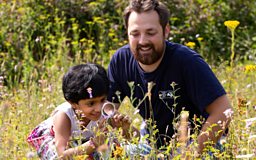
Closer to home, why not leave your lawn, or a section of your lawn, unmown and watch the insects flock to the clover, buttercups or dandelions that bloom, or nestle amongst the longer grass. Or, plan your own mini-meadow, sown with a wildflower seed mix in early autumn on a patch of soil. No garden? No problem! Plan to sow one in a growbag or tub in Spring.
🐝 Go On A Bee Safari...
If you’re off to a wildflower meadow, sat in the garden or heading out to the park, go bee-spotting! Alison Benjamin, the writer and co-founder of says:
The bumblebees are the easiest to spot, as they are large, round and fluffy’Alison Benjamin, writer and co-founder of Urban Bees
"You can even do a bee safari if you’ve only got a window box or a pot on a patio, as long as there are flowers in a sunny spot, bees will come to feast on the flowers’ nectar and pollen – it’s all they eat."
Arm yourself with Alison’s bee guide for Autumn or the Bumblebee Conservation Trust also have a !

Here are Alison’s top tips:
- Sit quietly, wait and enjoy seeing the visiting bees. Wild bees are very docile and very rarely sting – only if they are threatened.
- The bumblebees are the easiest to spot, as they are large, round and fluffy. The common carder bee is a type of bumble. They often have balls of pollen on their back legs, as does Davies’ plasterer bee, which gets its name from plastering its nest in a saliva-like water-proof liquid.
- There are lots of small black bees flying this month. Look out for the tiny scissor bees inside harebells (campanulas) and slightly bigger furrow bees in hardy geraniums.
- And if you’re really eagled-eyed you may see a leafcutter bee cutting a disc out of a leaf which she takes home to plug her nest.
- What you are witnessing is something that bees have been doing for more than 60 million years – playing Cupid and pollinating the flowering plants.
- Happy bees spotting!
🐝 Keep (Bees) Hydrated
It’s not just humans who need plenty of water in the summer heat! Give your buzzing visitors a drink by making a simple bee waterer with a saucer or shallow tub filled with marble, gravel or stones for the bees to perch on, and some water. Or add a resting spot to a pond or water feature that you already have in your garden to keep them safe!
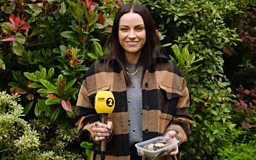
🐝 Have Some Family Fun

Our friends at ��������’s Tiny Happy People have come up with some great ideas for how to get involved with the Big Bee Challenge with your pre-schoolers. Ambassador, JLS star and beekeeper JB Gill has been teaching his two little ones Ace (5) and Chiara (2) about bees:
My son loves to ask what the bees do… I am just fascinated by how they operate… what they do up-close is mind-blowingly brilliantJB Gill
"My son loves to ask what the bees do. I explain the different types of bees within the colony and the jobs each of them does. I am just fascinated by how they operate and being able to sample just the tiniest snapshot of what they do up-close is mind-blowingly brilliant!"
How about turning your lawn into a bee observatory by growing some grass a little longer and mowing a sitting spot for young children to plop down and see what they can spot, or hear? Or try one of these bee-friendly activities.
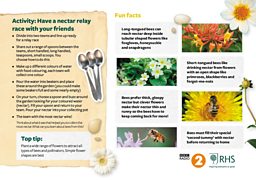
For older children, our partners the have put together these with family-friendly games and activities that help us all learn about bees and pollination. Why not try a nectar relay race with all the family?!
🐝 We’re buzzin’ to find out what you get up to!
Let us know by tagging us on social media @��������Radio2 and using #R2BigBeeChallenge.
Or show your support by and popping it in your window.
🐝 Listen to more on �������� Sounds
-
![]()
Bees In A Pod with Rob Beckett
Comedian Rob Beckett is on a mission to save the bees!
Like us on , on Instagram at , or follow us on Twitter
Listen to Radio 2 on �������� Sounds, or find out other ways you can listen.


